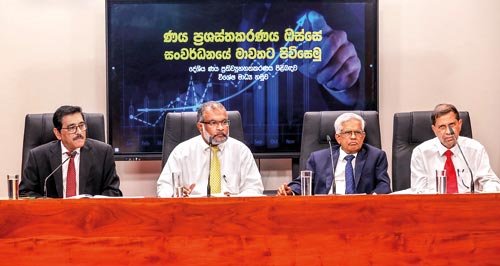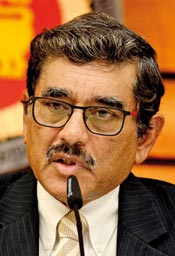Life after debt restructuring
View(s):
Officials at a DDO briefing.
As Sri Lanka’s debt restructuring attempt has now approached from the foreign debt to domestic debt, our discussions over it have got intensified too. Many seem to have felt earlier that as long as it is “foreign”, it is beyond our worries. Nevertheless, we were in panic mode in the last couple of days, only when it reached our doorstep targeting “domestic” debt restructuring.
The bottom line is that whether it is foreign or domestic, we have borrowed beyond our capacity and, perhaps, wasted it too so that it is our responsibility to pay it all back. When I tweeted this idea, one of the Tweet friends responded: The problem is that the “we” that borrowed are not the “we” that now have to pay it back!
My problem is “whom” should we keep out of the equation, since we all have contributed to it one way or the other? We never opposed borrowing on behalf us, but benefitted from borrowings, supported the “causes” of borrowings, blocked the reforms, chased away investments, and believed the miracle of “cheap politics”.
At one of the special lectures on “domestic debt restructuring” that I delivered this Thursday at Colombo University, at the concluding remarks I posed the question: “What comes after debt restructuring?” By the way, I didn’t leave out even the political question of “what comes after the next election?” The question seems so important, because such credible political discussion is rare in the Sri Lankan political arena.

File picture of Central Bank Governor Dr. Nandalal Weerasinghe
Debt sustainability
Let’s hope that everything goes according to plan: Both foreign and domestic debt restructuring will be concluded as expected and the IMF programme will be continued smoothly. What would we have achieved by then?
In the first place, we would have achieved debt sustainability. Our debt burden that was 128 per cent of GDP by the end of 2022 is too high. As one of the important debt sustainability targets, this ratio is expected to decline to 95 per cent by 2032.
In fact, if the debt burden of a developing country is reaching 100 per cent of GDP, it should alarm the policy makers. The Fiscal Management (Responsibility) Act, No. 3 of 2003 set the public debt target at around 75 per cent by 2025. The Maastricht Treaty 1993 set the public debt of Euro Zone member countries of the EU to 60 per cent of GDP, while the countries such as Greece, Portugal and Spain, which had violated the rule going beyond plunged into the so-called European debt crisis.
The second sustainability target is to reduce the “gross financing needs” from its 2022 level of 34.5 per cent of GDP to 13 per cent of annual average for the period 2027-2032. Gross financing needs of the government include the amount of money needed for meeting the annual debt repayment and covering the annual budget deficit.
Now here is the problem: Ultimately, money for debt repayment should come from the government revenue. Last year, the government revenue was Rs. 1972 billion, while total debt repayment was Rs. 2997 billion. The problem was already there even before the economic crisis: For instance, in 2018 government revenue was Rs. 1920 billion, while total debt repayment was Rs. 2088 billion. It shows that the country has already been heading to an unsustainable debt obligation, which was covered with further borrowings every year.
Foreign debt obligation
The third area of debt sustainability is the foreign debt obligation, which is part of the total debt repayment. It is expected to reduce the foreign debt service from its current ratio of 9.4 per cent of GDP to an annual average below 4.5 per cent of GDP for the period 2027-2032.
 After all, money for foreign debt repayments too should come from the government budget, or in other words, government’s tax revenue. Because the government does not earn Dollar-incomes, the Rupee allocations from taxpayers’ money must be converted to Dollars in order to repay foreign loans. This means that the country should have a continuous inflow of foreign exchange earnings in order to change into Rupees for anyone who needs Dollars, including the government.
After all, money for foreign debt repayments too should come from the government budget, or in other words, government’s tax revenue. Because the government does not earn Dollar-incomes, the Rupee allocations from taxpayers’ money must be converted to Dollars in order to repay foreign loans. This means that the country should have a continuous inflow of foreign exchange earnings in order to change into Rupees for anyone who needs Dollars, including the government.
Where do countries generate stable foreign exchange inflows? Its exports! Then, here is another problem: Sri Lanka’s export revenue has fallen down from 33 per cent of GDP to below 15 per cent of GDP during the past 20 years from 2000-2020, while the country needed more dollars to pay off rising foreign debt obligations.
While the debt restructuring process is aimed at achieving debt sustainability, it is supported by tax reforms and public enterprise reforms. Taxes were raised since the beginning of the year, while the tax net is widening in order to ensure more people pay income tax. Fuel and electricity prices were raised to cover the costs, because selling below the cost has been a major reason for losses of the public enterprises. The government has already absorbed the outstanding government-guaranteed debt of the public enterprises, while these institutions too are now under the reforms.
Recovery and beyond
With debt restructuring, the country will improve its debt sustainability and regain its credit worthiness. As at present, Sri Lanka with its debt-default is not a “credit-worthy” country, according to credit rating agencies as well as the country’s international sovereign bond (ISB) market performance.
While the debt sustainability would be improving, the country would be able to borrow again. Yet, the question remains: Is that what we expect? It is too unrealistic to say that the government will not have to borrow again. There is a financial need which has to be met with borrowings. In fact, a few days ago, the World Bank too announced its budgetary support– it’s again borrowing! The question is whether the whole episode of the debt crisis and debt restructuring would be ending with just regaining the borrowing ability of the country.
Further, with the conclusion of the debt restructuring process, Sri Lanka will have to start repaying its suspended foreign debt obligations with arrears. According to Finance Ministry information, government’s foreign debt stock is over US$40 billion, including $2.8 billion arrears by the end of 2022. Similarly, the total foreign debt of the public enterprises amounts to $2 billion with $385 million arrears.
Sustaining the debt sustainability
Debt sustainability cannot be sustained without foreign exchange earnings. As of now, we are focusing on three sources of foreign exchange inflows, which have worked well in the short term. The first is to regain foreign borrowings that were enabled by the successful conclusion of the IMF agreement. The second and third sources are the anticipated recovery in tourism earnings and worker remittances.
Neither of the above sources of foreign exchange earnings – borrowings, tourism earnings, and worker remittances, would sustain the country’s long-term debt sustainability as well as the growth prospects to become a developed country. In fact, the economy’s heavy reliance on any of these foreign exchange sources would be dangerous too, because such volatile foreign exchange flows might increase the vulnerability of the economy to external shocks.
Both long-term debt sustainability and the growth prospects must be based on export growth, and nothing but export growth. Accordingly, eliminating the deep-rooted “anti-export bias” and accelerating export growth remains at the heart of Sri Lanka’s policy-making.
The issue is more complex than debt restructuring too. At the implementation levels, debt restructuring is more a technical matter than a policy matter, but export growth requires policy and regulatory reforms as well as political stability. These factors are fundamental to win back investor confidence, because it is the investors and not the government which would accelerate export growth.
(The writer is a former Professor of Economics at the University of Colombo and can be reached at sirimal@econ.cmb.ac.lk and follow on Twitter @SirimalAshoka).
Hitad.lk has you covered with quality used or brand new cars for sale that are budget friendly yet reliable! Now is the time to sell your old ride for something more attractive to today's modern automotive market demands. Browse through our selection of affordable options now on Hitad.lk before deciding on what will work best for you!


